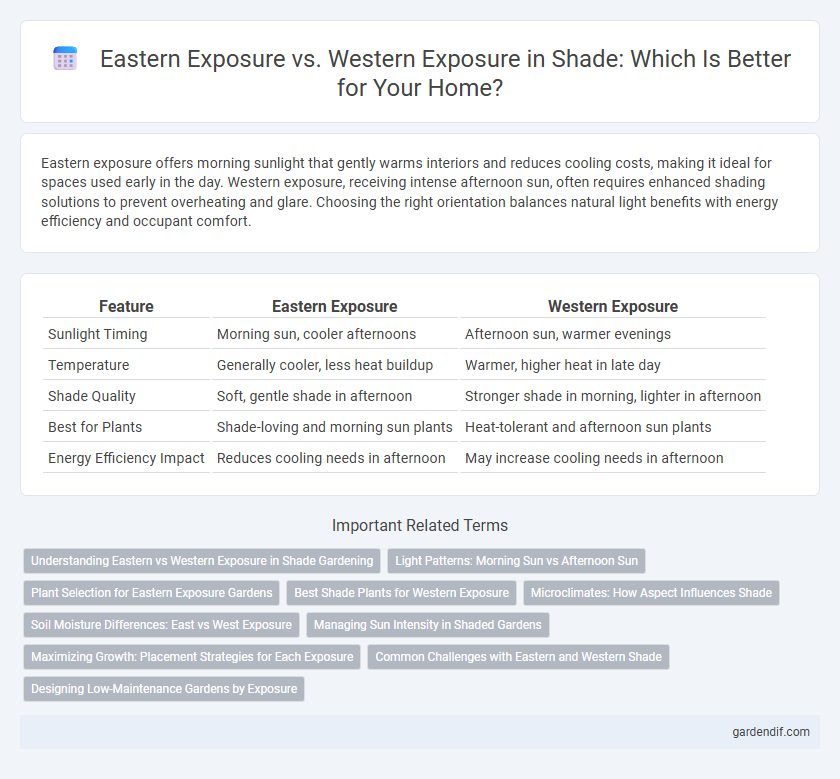
Eastern Exposure vs Western Exposure Illustration
Eastern exposure offers morning sunlight that gently warms interiors and reduces cooling costs, making it ideal for spaces used early in the day. Western exposure, receiving intense afternoon sun, often requires enhanced shading solutions to prevent overheating and glare. Choosing the right orientation balances natural light benefits with energy efficiency and occupant comfort.
Table of Comparison
| Feature | Eastern Exposure | Western Exposure |
|---|---|---|
| Sunlight Timing | Morning sun, cooler afternoons | Afternoon sun, warmer evenings |
| Temperature | Generally cooler, less heat buildup | Warmer, higher heat in late day |
| Shade Quality | Soft, gentle shade in afternoon | Stronger shade in morning, lighter in afternoon |
| Best for Plants | Shade-loving and morning sun plants | Heat-tolerant and afternoon sun plants |
| Energy Efficiency Impact | Reduces cooling needs in afternoon | May increase cooling needs in afternoon |
Understanding Eastern vs Western Exposure in Shade Gardening
Eastern exposure in shade gardening provides gentle morning sunlight that encourages growth without intense heat, ideal for plants like ferns and hostas that thrive in partial shade. Western exposure delivers stronger afternoon sun, creating warmer conditions that benefit shade-tolerant plants requiring more light, such as hydrangeas and astilbes. Understanding the differences between Eastern and Western exposure helps gardeners select appropriate plants and optimize shade garden health and aesthetics.
Light Patterns: Morning Sun vs Afternoon Sun
Eastern exposure delivers soft, warm morning sun that gradually brightens indoor spaces, ideal for rooms used early in the day. Western exposure exposes interiors to intense, direct afternoon sunlight, creating stronger heat and glare during late hours. Light patterns from eastern exposure promote cooler, diffused ambiance while western exposure leads to brighter, warmer environments later in the day.
Plant Selection for Eastern Exposure Gardens
Eastern exposure gardens benefit from morning sun and afternoon shade, making them ideal for plants that thrive in partial sunlight and cooler temperatures. Suitable plant selections include ferns, hostas, azaleas, and bleeding hearts, which prefer filtered light and avoid the harsh afternoon sun typical of western exposures. These species exhibit robust growth and vibrant foliage in eastern exposures, where sunlight intensity is moderate and moisture retention in soil is better maintained.
Best Shade Plants for Western Exposure
Western exposure receives intense afternoon sunlight, making it ideal for shade plants that thrive in bright, warm conditions. Succulents such as agave and aloe, along with shade-tolerant shrubs like boxwood and Japanese maple, perform exceptionally well in western-facing gardens. These plants are adapted to withstand strong sun and heat, providing lush greenery and vibrant foliage despite the challenging light.
Microclimates: How Aspect Influences Shade
Eastern exposure typically creates cooler microclimates in the afternoon by providing morning sun and afternoon shade, which benefits shade-loving plants needing gentle light. Western exposure results in warmer microclimates with intense afternoon sun, causing prolonged shade during mornings and increasing heat stress for shade-tolerant species. Understanding these microclimate variations helps optimize plant selection and placement to maximize shade benefits in landscaping.
Soil Moisture Differences: East vs West Exposure
Eastern exposure receives morning sunlight, resulting in cooler temperatures and higher soil moisture retention due to reduced evaporation rates. Western exposure faces intense afternoon sun, causing warmer soil conditions and faster moisture depletion, which can stress plants requiring consistent hydration. Understanding these soil moisture differences is crucial for selecting suitable plant species and optimizing irrigation strategies for each exposure type.
Managing Sun Intensity in Shaded Gardens
Eastern exposure in shaded gardens offers gentle morning sunlight that helps manage sun intensity by reducing heat stress on plants, promoting healthy growth without excessive sun exposure. Western exposure receives stronger afternoon sunlight, which can increase heat and water evaporation, requiring careful plant selection and additional shade structures to protect sensitive foliage. Effective management of sun intensity in shaded gardens involves balancing these exposures to optimize light conditions and maintain consistent moisture levels.
Maximizing Growth: Placement Strategies for Each Exposure
Eastern exposure offers morning sunlight ideal for seedlings and shade-tolerant plants, maximizing growth by avoiding harsh afternoon sun that can cause stress. Western exposure provides intense afternoon light suitable for heat-loving plants, but strategic placement of shade elements like pergolas or deciduous trees can prevent overheating and water loss. Positioning plants according to these light patterns optimizes photosynthesis, promotes healthy development, and extends the growing season.
Common Challenges with Eastern and Western Shade
Eastern and Western exposures pose unique shading challenges due to varying sun angles and intensity throughout the day. Eastern shade often faces harsh morning sun that can cause rapid temperature fluctuations and stress to plants, while Western shade deals with prolonged afternoon heat leading to potential dehydration and leaf scorch. Both exposures require careful plant selection and strategic placement to mitigate these common issues and ensure healthy growth in shaded environments.
Designing Low-Maintenance Gardens by Exposure
Eastern exposure offers morning sunlight that supports shade-tolerant plants requiring gentle light, ideal for low-maintenance gardens needing minimal watering and pruning. Western exposure delivers intense afternoon sun, favoring hardy, drought-resistant plants that thrive with less frequent care and withstand heat stress. Designing gardens by exposure optimizes plant selection, reduces maintenance efforts, and enhances landscape durability.
Eastern Exposure vs Western Exposure Infographic

 gardendif.com
gardendif.com